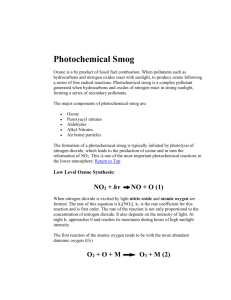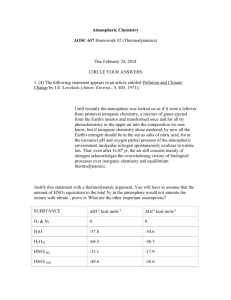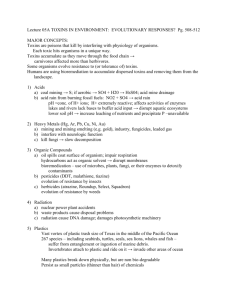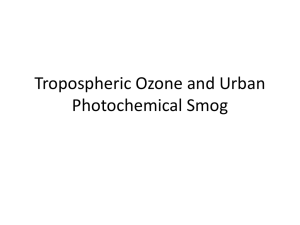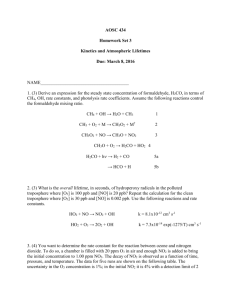Modeling Guidance and Examples for Commonly Asked Questions
advertisement
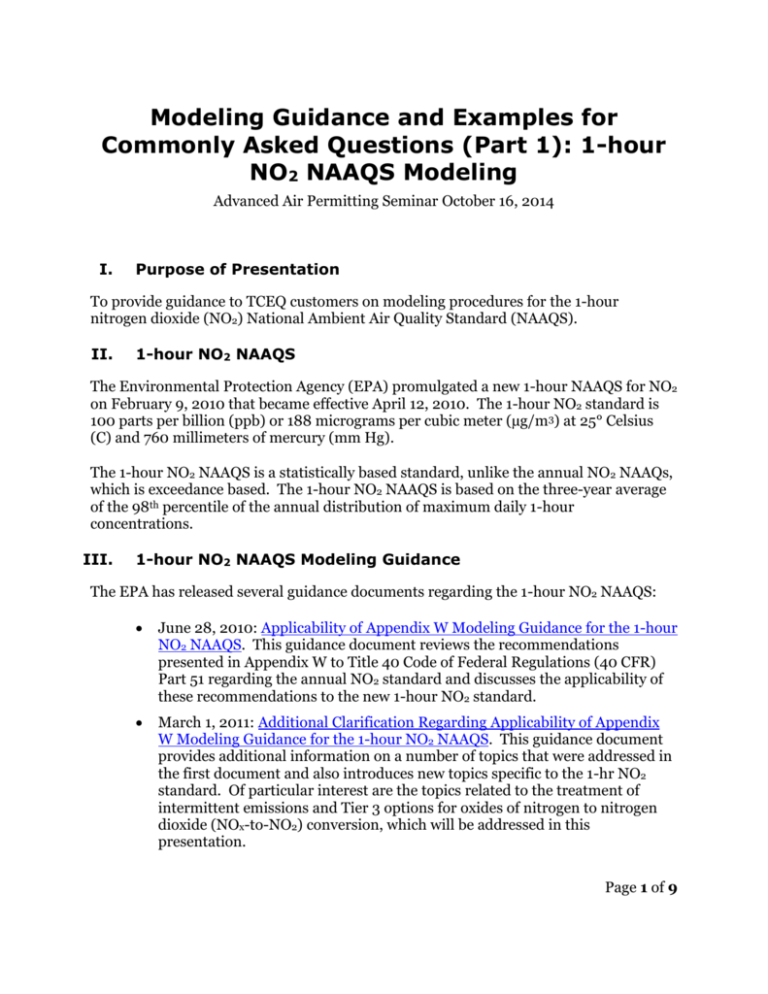
Modeling Guidance and Examples for Commonly Asked Questions (Part 1): 1-hour NO2 NAAQS Modeling Advanced Air Permitting Seminar October 16, 2014 I. Purpose of Presentation To provide guidance to TCEQ customers on modeling procedures for the 1-hour nitrogen dioxide (NO2) National Ambient Air Quality Standard (NAAQS). II. 1-hour NO2 NAAQS The Environmental Protection Agency (EPA) promulgated a new 1-hour NAAQS for NO2 on February 9, 2010 that became effective April 12, 2010. The 1-hour NO2 standard is 100 parts per billion (ppb) or 188 micrograms per cubic meter (µg/m3) at 25° Celsius (C) and 760 millimeters of mercury (mm Hg). The 1-hour NO2 NAAQS is a statistically based standard, unlike the annual NO2 NAAQs, which is exceedance based. The 1-hour NO2 NAAQS is based on the three-year average of the 98th percentile of the annual distribution of maximum daily 1-hour concentrations. III. 1-hour NO2 NAAQS Modeling Guidance The EPA has released several guidance documents regarding the 1-hour NO2 NAAQS: June 28, 2010: Applicability of Appendix W Modeling Guidance for the 1-hour NO2 NAAQS. This guidance document reviews the recommendations presented in Appendix W to Title 40 Code of Federal Regulations (40 CFR) Part 51 regarding the annual NO2 standard and discusses the applicability of these recommendations to the new 1-hour NO2 standard. March 1, 2011: Additional Clarification Regarding Applicability of Appendix W Modeling Guidance for the 1-hour NO2 NAAQS. This guidance document provides additional information on a number of topics that were addressed in the first document and also introduces new topics specific to the 1-hr NO2 standard. Of particular interest are the topics related to the treatment of intermittent emissions and Tier 3 options for oxides of nitrogen to nitrogen dioxide (NOx-to-NO2) conversion, which will be addressed in this presentation. Page 1 of 9 IV. Treatment of Intermittent Emissions The modeling of intermittent emission sources and intermittent emission scenarios has become one of the challenges in conducting compliance demonstrations for 1-hour NO2 NAAQS. Examples of intermittent emission sources include diesel engines used for firewater pumps and emergency generators. Examples of intermittent emission scenarios include startup/shutdown operations. These sources typically operate infrequently or on a random operating schedule. Emission sources are typically modeled at the maximum hourly emission rate and assumed to operate continuously for all hours of the year. This approach ensures that the worst-case meteorological conditions that could happen in a given year are accounted for in the modeling demonstration. However, applying this approach to intermittent emission sources, which do not operate continuously throughout the year, often results in the sources becoming the culpable emission scenario. It should also be noted that firewater pumps and emergency generators typically have low release heights, which can further increase the impacts of these sources on the modeled 1-hr NO2 design value. The EPA has suggested using a modeled hourly emission rate to represent intermittent emissions based on the facility’s operating rather than the maximum hourly emission rate. This approach addresses both the worst-case meteorological conditions that could occur during the intermittent emissions as well as the probability of the intermittent emissions occurring. In assuming continuous operation of the source, the worst-case meteorological conditions that occur during a given year will be accounted for in the modeling demonstration. In addition, using an adjusted hourly emission rate based on represented hours of operation can account for the probability of the source operating during a given hour. The calculation of the modeled hourly emission rate is based off of the maximum hourly emission rate and the annual operating hours of the source, and is as follows: Based on the calculation above, the modeled hourly emission rate for a firewater pump tested 52 hours per year would be equal to the maximum hourly emission rate multiplied by 52/8760. It is important to note that the hours per year in the calculation above could vary if the intermittent emission source has restrictions on the number of hours it can operate in a given day. This concept is discussed further below. Emission scalars are often used to represent operational restrictions for modeled sources. If operational restrictions for an intermittent emission source are incorporated Page 2 of 9 in the modeling demonstration, then the calculation for the modeled hourly emission rate must account for the operational restrictions. The operational restrictions can be accounted for by adjusting the hours per year in the average emission rate calculation above. For example, assume that there is a firewater pump engine that is tested for 52 hours per year. In addition, the testing can only occur between the hours of 8 a.m. and 6 p.m. The modeling demonstration incorporates the operational restriction through the use of emission scalars. Since the testing can only occur during a ten hour window, the total hours per year available for testing would be 3650 hours (10 hours per day multiplied by 365 days per year). The modeled hourly emission rate would be equal to the maximum hourly emission rate multiplied by 52/3650. In addition to the operational restrictions discussed above, operational restrictions also exist for the Houston-Galveston-Brazoria (HGB) and Dallas-Fort Worth (DFW) ozone nonattainment areas for emergency engines. These restrictions are documented in Title 30 Texas Administrative Code (30 TAC) Chapter 117, which addresses the control of air pollution from nitrogen compounds. The specific sections are listed below: 30 TAC § 117.2030(c): Operational restrictions for the HGB ozone nonattainment area 30 TAC § 117.2130(c): Operational restrictions for the DFW ozone nonattainment area These two sections state that the operation of any stationary diesel or dual-fired engine for testing or maintenance cannot occur between the hours of 6 a.m. and 12 p.m., with some exceptions. In this case, there are a total of 18 hours per day available for engine testing or maintenance. The total hours per year available for testing or maintenance would be 6570 hours (18 hours per day multiplied by 365 days per year). The modeled hourly emission rate for a firewater pump tested 52 hours per year would be equal to the maximum hourly emission rate multiplied by 52/6570. V. Intermittent Emissions Source Determination The treatment of intermittent emissions discussed above can only be applied to those sources which would not be expected to contribute significantly to the annual distribution of the maximum daily 1-hour concentrations. The TCEQ Air Dispersion Modeling Team (ADMT) requests that the following information be provided as justification for using the EPA intermittent emission guidance: How many sources are there? The combined operations of all emission sources are evaluated as a whole to determine if the emissions have the potential to contribute significantly to the annual distribution of maximum daily 1-hour concentrations. How often does the source operate per year? Provide the permitted annual operating hours for each source. Page 3 of 9 What is the duration of operation once the source is operating? Intermittent emissions can last from a few hours to several days each time the source operates. Does the source operate on a known schedule, or does it operate randomly? Describe the frequency of the source operations. For example, firewater pump engines are often tested once per week or once per month. Startup/shutdown operations often occur only a few times per year. Does the source operate simultaneously with other sources? If several sources can operate simultaneously or within the same day, the potential for the intermittent emissions to significantly affect the annual distribution of maximum daily 1-hour concentrations is reduced. A few examples are presented below to illustrate these points. For the first example, the applicant has seven firewater pump engines at the project site. Each engine is tested for approximately one hour per week and no more than 52 hours per year. In addition, the engine testing can occur over multiple days of the week. Based on the information provided by the applicant, the firewater pump engines do have the potential to contribute significantly to the annual distribution of maximum daily 1hour concentrations. Since there are seven engines and each one is tested once per week, it is possible that the testing could occur seven days per week and 365 days per year. The EPA guidance also provides a similar example in which a source is permitted to operate 365 hours per year. It is also noted that this source is operated as part of a process that occurs once per day. While the total permitted hours of operation are small compared to the hours in a year, the source operates 365 days per year and would not meet the intent of the intermittent source guidance. The second example is similar to the example above. The applicant has seven firewater pump engines at the project site. Each engine is tested for approximately one hour per week and no more than 52 hours per year. However, unlike the previous example, the applicant will be testing all seven engines on the same day. Based on the information provided by the applicant, the firewater pump engines do not have the potential to contribute significantly to the annual distribution of maximum daily 1-hour concentrations; the intermittent source guidance could be applied to the testing of the firewater pump engines. In this scenario, the testing of the engines would only occur for one day per week and 52 days per year. VI. Tier 3 Options for NOx-to-NO2 Conversion Appendix W to 40 CFR Part 51, otherwise known as the Guideline on Air Quality Models, includes a multi-tiered screening approach for estimating annual NO2 concentrations. The tiers are as follows: Tier 1: assume total conversion of NOx to NO2 Page 4 of 9 Tier 2: ambient ratio method. Multiply the annual predicted NOX concentration by national default ratio of 0.75 Tier 3: detailed screening analysis The same tiered approach can be applied to the estimation of 1-hour NO2 concentrations, with the exception of Tier 2. If a Tier 2 analysis is conducted for the 1-hr NO2 modeling demonstration, the 1-hour predicted NOx concentration should be multiplied by a NO2/NOx ratio of 0.80. This presentation focuses on the Tier 3 options for estimating NOx-to-NO2 conversion. Currently, there are two options available within AERMOD - the Plume Volume Molar Ratio Method (PVMRM) and the Ozone Limiting Method (OLM). PVMRM and OLM are treated as non-default model options. An applicant must submit a modeling protocol documenting the proposed modeling approach before submitting modeling with these options. PVMRM and OLM account for the conversion of NOx to NO2 through the chemical mechanism of ozone titration. This chemical mechanism is illustrated below: NO + O3 → NO2 + O2 In order to simulate this conversion process, AERMOD requires several model inputs. These inputs are: VII. In-stack NO2/NOx ratios Background ozone concentrations Ambient NO2/NOx equilibrium ratio In-stack NO2/NOx Ratios The in-stack NO2/NOx ratio is the ratio of the NO2 to NOx emissions exiting the source stack. The EPA default ratio is 0.5. The use of a non-default ratio will require sufficient technical justification from the applicant and approval from the permit engineer before being incorporated into the model. There are two options that can be used to enter the in-stack ratios in AERMOD: CO NO2STACK keyword: enter a single ratio that will be applied to all modeled sources SO NO2RATIO keyword: enter specific ratios on a source by source basis It is recommended that applicants use in-stack ratios specific to the modeled sources, rather than using the default in-stack ratio. The in-stack ratio will have the greatest Page 5 of 9 influence on predicted concentrations located at the receptors nearest to the model sources, which is typically the location of the maximum predicted concentrations. A modeling demonstration using the default in-stack ratio may result in predicted impacts similar to the Tier 2 ambient ratio method. VIII. Background Ozone Concentrations There are several options that can be used to enter the ozone background concentrations in AERMOD: CO OZONEVAL keyword: enter a single ozone background concentration. CO O3VALUES keyword: enter temporally-varying ozone concentrations. This option allows ozone concentrations to vary by hour of day, month, season, etc. CO OZONEFIL keyword: enter hour-by-hour ozone concentration data in a separate file. The first two keywords can be used to fill in missing data in the hourly ozone concentration file. As is the case with all background concentrations, the applicant must provide sufficient technical justification for the ozone background concentrations used in the modeling demonstration. The justification should demonstrate the ozone monitor used to derive the background concentrations is representative of the modeling domain. In addition, if the ozone concentrations are entered in AERMOD through an hourly ozone concentration file, the meteorological data used in the modeling demonstration must correspond to the years of the ozone concentration data. For example, if five years of ozone data are used for the years 2009-2013, the meteorological data must also correspond to the years 2009-2013. Representative meteorological data would need to be processed with AERMET with surface characteristics (albedo, Bowen ratio, and surface roughness) specific to the modeling domain. Given the discussion in the paragraph above, using the most recent years of ozone monitor data (2009-2013) in a Tier 3 modeling demonstration will require the processing of meteorological data, since the current TCEQ preprocessed meteorological datasets available span the years 2008-2012. A simple yet conservative approach is presented here for those applicants who wish to use the TCEQ preprocessed meteorological datasets in a Tier 3 modeling demonstration: Obtain representative hourly ozone concentration data from the most recent, complete year of monitor data For each hour of the day, determine the highest ozone concentration that occurred during the year Page 6 of 9 Enter these 24, 1-hour concentration values in AERMOD using the CO O3VALUES HROFDY keyword This approach represents an ozone “super day” and will maximize the amount of NOxto-NO2 conversion in the modeling demonstration. IX. Ambient NO2/NOx Equilibrium Ratio The EPA default value for the ambient NO2/NOx equilibrium ratio is 0.9. The use of a non-default ratio will require sufficient technical justification from the applicant and approval from the ADMT before being incorporated into the model. However, it should be noted that the equilibrium ratio is typically reached far beyond the point of maximum predicted ground level concentrations. As noted above in the discussion of the in-stack NO2/NOx ratio, the maximum predicted ground level concentrations typically occur at receptors closest to the model sources. Using source specific in-stack ratios will have a greater influence on the predicted concentrations than using area specific equilibrium ratios in most cases. X. Choice of Tier 3 Model Options The EPA currently does not have a preference for one option over the other. However, there are cases where PVMRM will perform better than OLM, and vice versa. The reason for this is in the way that the two options estimate the amount of ozone available for conversion. PVMRM estimates the amount of ozone available for conversion based on the amount of ozone within the volume of the plume for an individual source or group of sources. OLM estimates the amount of ozone available for conversion based on the ambient ozone concentration and is independent of source characteristics. PVMRM works well for isolated elevated point sources. In these cases, PVMRM estimates the amount of ozone available for conversion based on the volume of the plume as it is transported downwind and accounts for the influence of meteorological conditions on the entrainment of ozone into the plume. This will result in more refined predicted concentrations than OLM, which estimates the amount of ozone available for conversion based simply on the ambient ozone concentration. However, OLM may be the better choice for low level releases and area sources. For low level releases, the modeled plume may extend below ground level. PVMRM will still use the full volume of the plume to estimate the NOx-to-NO2 conversion in this scenario. This may lead to overly conservative predicted concentrations due to the overestimation of the plume volume. For area sources, PVMRM uses the projected width of the area source to determine the lateral extent of the plume, even though a nearby receptor may only be impacted by a portion of the area source. The overestimation of the plume volume could lead to overly conservative modeling results for area sources in these cases. Page 7 of 9 These examples illustrate that one option is not superior to the other, and the option used should be determined based on the sources involved in the modeling demonstration. XI. Additional Considerations Regarding the Use of the Tier 3 Options Please note that the EPA intermittent source guidance should not be used in conjunction with the PVMRM or OLM model options. The use of an average hourly rate, as suggested in the intermittent source guidance, may not result in a reasonable estimation of the amount of NOx converted to NO2. If an applicant wishes to use the intermittent source guidance and one of the Tier 3 options in the same model run, then the following procedure should be followed: For the sources that meet the intermittent source criteria: o Use the average hourly emission rate o Use an in-stack NO2/NOx ratio of 1.0 For all other sources: o Use the maximum hourly emission rate o Use source specific in-stack NO2/NOx ratios Using an in-stack ratio of 1.0 will represent full conversion to NO2, which effectively turns off the algorithms for PVMRM and OLM. XII. Recent Updates On September 30, 2014, the EPA released new guidance regarding the 1-hour NO2 NAAQS in the document: “Clarification on the Use of AERMOD Dispersion Modeling for Demonstrating Compliance with the NO2 National Ambient Air Quality Standard.” This document provides additional guidance on the in-stack NO2/NOx ratio used in the Tier 3 model options. In addition, the document provides guidance on the use of a new Tier 2 model option for NO2. As noted previously, the default in-stack NO2/NOx ratio for use in the Tier 3 model options is 0.5. According to the recent guidance, this ratio will remain the default for the primary source. A default in-stack NO2/NOx ratio of 0.2 can be used for “distant nearby” sources in a cumulative NAAQS modeling demonstration. The ADMT is currently reviewing the guidance to determine the criteria for defining a “distant nearby” source. Page 8 of 9 The EPA also provided guidance on the use of the Ambient Ratio Method 2 (ARM2) for use in Tier 2 NO2 modeling demonstrations. The ARM2 model option was recently incorporated in AERMOD version 13350. The ADMT is currently reviewing the guidance to determine the criteria for which the use of this option would be appropriate. Page 9 of 9

